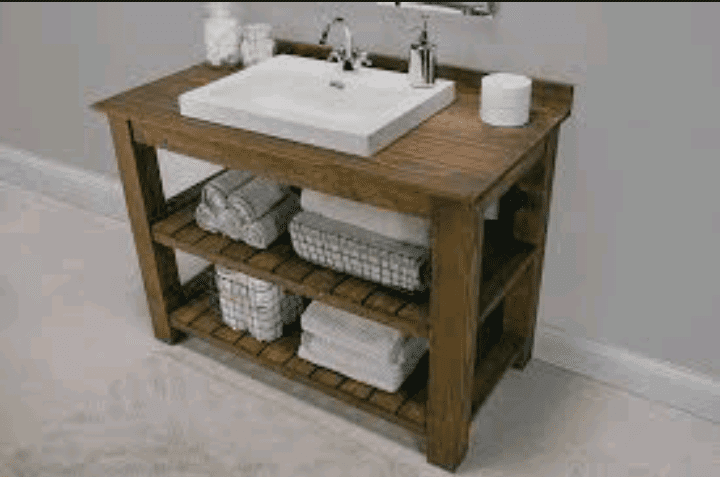Creating your own DIY bathroom vanity is a venture into the realm of self-expression and functional design. In the hustle and bustle of daily life, our bathrooms serve as a haven of calm and preparation.
What better way to enhance this personal space than by crafting a vanity that not only meets your practical needs but also reflects your unique style?
The idea behind a DIY bathroom vanity is simple – it’s about putting your personal touch on an essential element of your home. Whether you’re a seasoned DIY enthusiast or a first-timer, this project offers a rewarding experience that goes beyond the final result.
It’s a chance to infuse your bathroom with elegance and functionality tailored to your preferences.
Imagine a vanity perfectly suited to your space, designed by you, and crafted with materials that resonate with your taste. This article will guide you through the step-by-step process, from the initial planning stages to the finishing touches.
No need to be a master carpenter; with a bit of creativity and dedication, you can transform your bathroom into a space that truly feels like your own.
We’ll explore the considerations that go into the planning and design phase, delve into the array of materials you can choose from, and guide you through the hands-on process of building your DIY bathroom vanity.
By the end, you’ll not only have a functional and stylish piece but also a sense of accomplishment that comes with creating something unique for your home. So, let’s roll up our sleeves and embark on this journey of DIY bathroom vanity transformation together!
Read also: DIY Pallet Projects: Unleashing Your Creativity
DIY Bathroom Vanity

1. Planning and Design
Before diving into the hands-on work, a well-thought-out plan is crucial for a successful DIY bathroom vanity project. Begin by assessing your space, taking into consideration the dimensions and layout of your bathroom. Consider the style and aesthetics you want to achieve – modern, rustic, or perhaps a vintage charm?
A. Design Considerations:
- Measure the available space for the vanity.
- Decide on the number of sinks and their placement.
- Choose a style that complements the overall bathroom design.
- Consider storage needs and incorporate drawers or shelves accordingly.
B. Sketching and Visualization:
- Sketch a rough design of your envisioned vanity.
- Utilize online tools or software for a more detailed visualization.
- Consider the placement of faucets, handles, and any additional features.
2. Selecting Materials
Now that the design is in place, the next step is choosing the right materials. Your choices will not only impact the aesthetic appeal but also the durability and functionality of the vanity.
A. Wood Selection:
- Opt for moisture-resistant wood, such as teak or oak.
- Consider reclaimed wood for an eco-friendly touch.
- Ensure the wood complements the overall style of your bathroom.
B. Countertop Options:
- Choose a durable material like granite, quartz, or marble.
- Consider budget-friendly alternatives like laminate or concrete.
- Ensure the countertop material aligns with your maintenance preferences.
C. Sink and Faucet Selection:
- Select a sink material that complements the vanity and is easy to clean.
- Choose faucets that match the overall style and finish of the vanity.
3. Building the Vanity Structure
With the design and materials in place, it’s time to start building your DIY bathroom vanity. This section will guide you through the step-by-step process.
A. Cutting and Assembling:
- Use precise measurements to cut the wood pieces.
- Assemble the vanity frame, ensuring stability and levelness.
- Secure joints with wood glue and screws for added durability.
B. Adding Storage Features:
- Incorporate drawers and shelves based on your design.
- Use drawer slides for smooth functionality.
- Ensure proper spacing for plumbing if incorporating a sink cabinet.
C. Mounting the Countertop:
- Securely attach the chosen countertop to the vanity base.
- Follow manufacturer instructions for installation.
- Ensure proper sealing for water resistance.
Read also: DIY Cat Tree: Crafting Feline Bliss at Home
4. Finishing Touches
The finishing touches are what elevate your DIY bathroom vanity from a project to a masterpiece. This section covers the final steps to complete your creation.
A. Sanding and Smoothing:
- Sand the entire vanity to achieve a smooth finish.
- Round edges for a polished look.
- Wipe off any dust before moving to the next step.
B. Staining or Painting:
- Choose a stain or paint that complements your bathroom’s color scheme.
- Apply multiple coats for a professional finish.
- Allow sufficient drying time between coats.
C. Sealing and Protecting:
- Apply a clear sealant to protect the wood from moisture.
- Ensure all surfaces, especially around sinks and faucets, are well-sealed.
- Consider using a waterproofing agent for added protection.
5. Installation and Maintenance
The final step is installing your DIY bathroom vanity and ensuring its long-term maintenance.
A. Installation:
- Securely anchor the vanity to the wall.
- Connect plumbing fixtures with care.
- Double-check for levelness and stability.
B. Maintenance Tips:
- Regularly clean the vanity with mild, non-abrasive cleaners.
- Avoid harsh chemicals that may damage the finish.
- Keep an eye on any signs of wear and address them promptly.
Read also: Waste Resource Recovery Techniques
